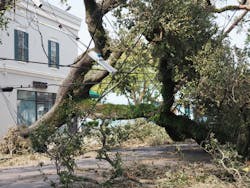Entergy Considering 10 Microgrids as an Alternative to Transmission
Entergy is considering building 10 natural gas-fired microgrids in its Louisiana service territory, which has been pummeled in recent years by storms that have caused widespread outages.
The utility described the microgrids in a 10-year resilience plan filed this week with the Louisiana Public Service Commission. The plan proposes $9.6 billion in spending on 9,600 transmission and distribution projects affecting more than 269,000 structures over 11,000 miles of power lines.
The utility is seeking commission approval for the first phase of the plan, which will spend $5 billion from 2024 to 2028.
“Absent the sort of commitment to and substantial investment in resilience measures included in the resilience plan, the Gulf Coast will be insufficiently prepared to address the future risks posed by extreme weather events, which are becoming more frequent, severe, unpredictable, and costly, and are disproportionately impacting the Gulf Coast region,” said Entergy in the plan.
Although Entergy described the microgrids in the filing, they are not actually part of the resilience spending plan. However, if built, they could substitute for some of the transmission measures put forward in the plan, the utility said.
Located across the state, the microgrids would act as local power resources “that can swiftly restore power to a substation, to the feeders that are connected to a substation, or to certain critical loads in the company’s distribution system,” the utility said.
The microgrids would connect to the utility system, so the system would need to be hardened against storms to ensure the microgrids could operate.
“In order to take full advantage of these newer technologies, any investment in those technologies must be made hand-in-hand with an investment in hardening the company’s distribution and transmission systems,” said Sean Meredith, vice president of system resilience for Entergy Services.
Why natural gas microgrids
Before deciding on natural gas, the utility evaluated several other potential resources to fuel the microgrids, including bulk energy storage, natural gas and storage, and solar and storage.
“The company determined that dispatchable natural-gas generators were the most cost effective and practical solutions to providing a storm-resilient generation source following a major storm considering the costs to construct the microgrids and the ability of the microgrids to provide power reliably following a major weather event,” Meredith said.
17.5 MW microgrid being considered
One project under consideration is a 17.5-MW microgrid connected to the utility’s Kentwood substation that would serve 30 industrial companies, about 70 government entities, about 300 commercial businesses and about 2,200 residential customers. As long as natural gas is available, the microgrid would provide power for the duration of a utility power outage.
Even when the grid operates normally, the microgrid would be put into service. It would provide wholesale energy, capacity and ancillary services, so that it could benefit the utility’s entire customer base – not just those who experience power outages.
Meredith said that it will cost more to build the microgrids than it would to harden transmission, but that “the microgrids, as decentralized sources of local power generation, may provide resilience benefits that are different from (and potentially more desirable than) those provided by the transmission solutions.”
Bronzeville microgrid a model
Philip May, president and CEO of Entergy Louisiana added in written testimony that most microgrids provide resilience to only a single entity, like a hospital or campus, but he noted that in some instances in the US, they serve multiple customers.
Entergy cited Exelon's 7-MW Bronzeville Community Microgrid project in Chicago, Illinois, which serves more than 1,000 electric customers and can interact with a second microgrid owned by the Illinois Institute of Technology.
“One obvious benefit to constructing a microgrid that serves a broader area (i.e., an entire substation, feeder, or lateral), as opposed to a single customer, is that the wider coverage brings incremental resilience to more customers who are contributing to its costs. But whether a microgrid is suitable for a broader area and a particular resilience application depends on a variety of factors, including the availability of suitable land and right of way access to natural gas sources or pipelines (in the case of a gas-powered microgrid), and the specific goals of the resilience solution,” Meredith said.
Track news about microgrids. Subscribe to the free Microgrid Knowledge Newsletter.
About the Author
Elisa Wood
Editor-in-Chief
Elisa Wood is the editor and founder of EnergyChangemakers.com. She is co-founder and former editor of Microgrid Knowledge.
